
The teams climbing from the Tibet side have now left Kathmandu. According to Phil Crampton of Altitude Junkies, > the delay in crossing the border was due to lack of “vehicles available for all the groups to enter around the same time so they have staggered the entry dates.”
Climbers and trekkers are required to hire a 4WD vehicle, typically a Land Cruiser, along with a Chinese driver from the China Tibet Mountaineering Association (CTMA). This driver will be with the team all the way to Base Camp where they will be handed over to a CTMA Liaison Officer.
Early reports show only seven teams climbing from Tibet and 47 different teams have permits on the south side. I would break this down as a very rough estimate to be 47 teams, 500 climbers, 700+ Sherpas/Staff on the South and 7 teams, 90 climbers/125+ Sherpas/Staff
Before the Climbing Begins
As the teams continue to arrive at Everest Base Camp, they have some serious business to attend to before climbing – their Puja.
Himalayan Ascent reports “Due to the unfortunate accident yesterday where a Sherpa (part of the route setting team) fell to his death into a crevasse, today’s ceremony was subdued”
Eric Simonson, IMG, say his Sherpas are now ready to start the serious climbing after having their Puja: “Tomorrow we have 27 Sherpas headed to Camp 2 and 22 Sherpas headed to Camp 1 to start building those camps.” His climbers will continue their acclimatization schedules by returning down valley to climb on Lobuche Peak.
Teams will start entering the Icefall for their first rotation around April 11th. But let’s look at the Puja ceremony a bit closer.
Tim Rippel, Peak Freaks, posted this today on their Puja:
Before any work begins on the mountain we’ll have a Puja ceremony, this ceremony is believed to make contact with divine Sagamartha (Mount Everest) and ask her for clear the passage for everyone, the Sherpa climbers will not climb before they are blessed, this will take place tomorrow morning so the trekkers can be part of it too. This is the most important blessing for our team; Western climbers, Sherpa climbers, food and equipment.
Climbing boots and axes and crampons will be piled around the Stupa, it’s a moving experience for anyone who has had the opportunity to be part of one, the burning of juniper and the chant from Lama Mingma, the tossing of rice and drinking of chang (or beer) all adding to this magical and spiritual event. Of course there is also a monetary part to help support the local monasteries.
And Dave Hahn, RMI, added this about their Puja:
this day had auspicious written all over it. Our Sirdar Lam Babu consulted the Tibetan calendar and made a few calls. This was the day for our Puja ceremony. A lama was brought up from Pangboche and our Puja Stupa was made ready. Today was the day for the entire team to get together for a Buddhist ceremony asking the gods to look favorably on our expedition. The Pangboche lama was actually pretty busy as several other teams were similarly in need of blessing. The drums started beating and the cymbals started clashing for ours just after lunch on another big blue sky day. A number of Sherpas from neighboring teams joined us in our celebration. There were chants and prayers and various offerings of juniper smoke, food and drink.
There were a number of things tossed into the sky and onto each other, principally rice and tsampa (barley flour) and a little chiang -a lightly fermented homemade rice wine with bits of orange. The climax of the ceremony begins with the Puja mast going up with strings of brightly colored prayer flags going out in all directions from it. Finally we all stand and toast each other, shake hands and ask each other to be careful on this climbing trip. The birds certainly enjoy the day as a whole flock of black Himalayan Chuffs (a little smaller than a crow) descend to get the spare offerings. We also enjoyed watching smaller sparrow and finch types joining in the festivities.
The Puja
The announcement is normally made at dinner, “Tomorrow we will have our Puja. Bring your harness, crampons, ice axes and anything sharp to the ceremony.” If you have never been to a Puja, your interest is now raised.
Breakfast comes early as the cooks and Sherpas are anxious to start the ceremony. A large stone Stupa has already been erected primarily to hold the flag pole and to hold a picture of the Dali Lama. Blankets are laid out for the climbers to sit on during the long ceremony.
The Sherpas are busy stringing the mulit-color prayer flags across the camp, all centered on the flag pole at the Stupa.
Soon the sounds of the fluttering flags cover the entire camp. Each flag has different meaning: yellow-earth, green water, red-fire, white-air, blue-space.
More Sherpas are busy starting a small juniper fire. The smoke will cover the entire camp. It is hazy, and fragrant. It marks the beginning of something special. This is not the last time to see this smoke. Every time before leaving Base Camp, each climber and Sherpa will pass by this same spot, letting the smoke from the juniper boughs cover them.
Everyone takes their place on the blankets after resting their climbing tools against the Stupa. Part of the ceremony is to ask forgiveness for hurting Sagamartha with the sharp points of the tools. But the most important part is to ask permission to climb the mountain and for safe passage.
The Lama begins with a low chant as he reads from the 300 year-old Tibetan prayer book. Everyone soon quiets down as the chanting occupies the entire team of Sherpas. Soon, a Sherpa laughs, others smile, the environment is respectful but not overly serious.
One Sherpa begins to walk around offering bread, and chiang to everyone. It is OK not to drink the fire water. The Sherpa will just smile and move on. Everyone is now relaxed as the Lama continues his chanting. A small black bird lands on the top of the flag pole, a Himalaya Chuff, it is a sign of good luck. Everyone smiles.
On a mysterious signal, everyone takes their handful of rice and throws it into the air three times, saying another mysterious chant. The Westerners have no clue, but it doesn’t matter, everyone now joins in.
The ground is hard and it is cold, Down coats were a good idea. After a while the Lama stops and everyone gets up and walks around. All of a sudden there is a commotion all around as a Sherpa with a handful of brown powered, barley flour, spreads it all over a climber’s face. It symbolizes a gray beard and long life. Soon everyone is smearing flour on each other.
More laughing and then the dancing starts. The Sherpas with arms around one another form line and begin a dance that would make the Rockettes proud. The climbers and trekkers join in. Another Sherpa walks around with a bottle of whiskey, carefully pouring a small amount in the bottle cap, most everyone has a taste. More laughs and smiles.
The ceremony ends with a whimper as people drift away, deep in their own thoughts as to what the ceremony meant to them. For the climbers, it might be optional, but for the Sherpas, they will not climb without the blessing.
I find it interesting, but not surprising that elite climbers Ueli Steck made this comment about their Puja:
“On the way back I met Dendi and Tenji to do a puja, which is a very important part of an expedition to me. It’s a Buddhist blessing, and for me it’s always important to respect the culture of the place I am visiting. At first, I did it mainly for the locals. Now I feel I really want to do it for myself. I hope this will provide us with good luck! We will see!
Showers
Meanwhile, not everyone is at Base Camp. Dave Mauro shares with us his shower technique at the village of Debuche:
I celebrated my arrival in Debuche last night with a shower and shave (300 rupees or$3.80). It felt incredibly good. I was reborn, renouncing my stench and a beard that was not worth keeping. When a shower can be had in this part of the world the water is heated by a low-flow on-demand unit mounted on the wall. The instructions will invariably caution that you not manipulate the dials. So the temperature you get is the temperature you shower with. In Debuche the temperature was a satisfying hot. But there is not an unlimited water supply. You are typically given 7 minutes of flow, so organization is everything. As none of the rooms or bathrooms in the Guest Houses are heated, I like to set everything out before disrobing; bar of soap, shampoo, wash cloth, towel, razor, and shaving cream. I also arrange the clothes I will put on after. Then I choose an up-tempo theme song to sing (“Milly, make some chilly”) and start the water. The flurry of activity which follows would probably impress a NASCAR pit crew.
And not to be left out, the ladies with the US Air Force team added these thoughts:
Ok, we’re more than a week into this trip and I think it’s time for the ladies’ perspective! In reality it’s probably not much different from the guys’… we’re just as dirty and smelly and constantly trying to avoid the bugs in the unsanitary water, foreign food, and unfamiliar living conditions. Megan and I have been relatively healthy so far, only dealing with a head cold. I’m not sure if its luck or prevention, but either way we’re happy with how things are going. We’ve been using hand sanitizer and baby wipes multiple times a day, trying to stick with boiled water and tea, and have also been avoiding most foods with meat. I’m not sure if there’s any basis to it but the rice, noodles, and veggies have been good to us so far.
Climb On!
Alan
Memories are Everything

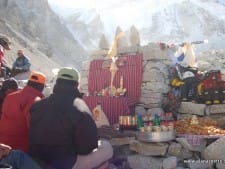
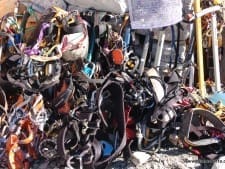

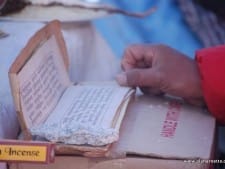

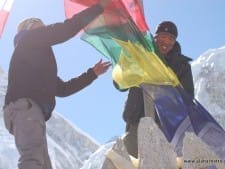
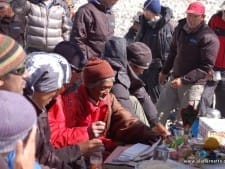
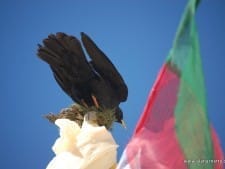
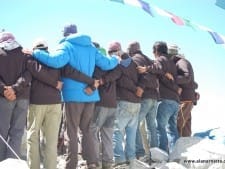

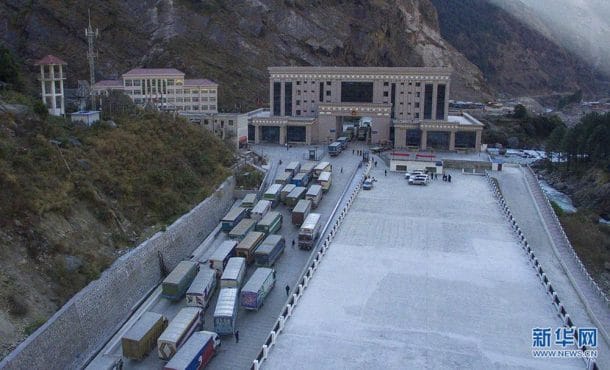
4 thoughts on “Everest 2013: Base Camp Puja”
Such a fantastic description of the Puja 🙂 Being a hindu, I can relate to the puja and the ingredients used. Thank you Alan. Wishing all the teams the very best and may Sagamartha take good care of them and return them safely x
Sounds to be very busy around Everest this year. Once again the South has many more expeditions, obviously guys love the 2 week trek. Cheers Kate
Huge crowd on South, as expected and I guess the tally doesn’t include Lhotse & Nuptse teams. This can safely be considered as most sacred congregation of mountaineers and climbers from all around the globe, with diverse levels of experience and various age groups.
An exceptionally good read.
Comments are closed.